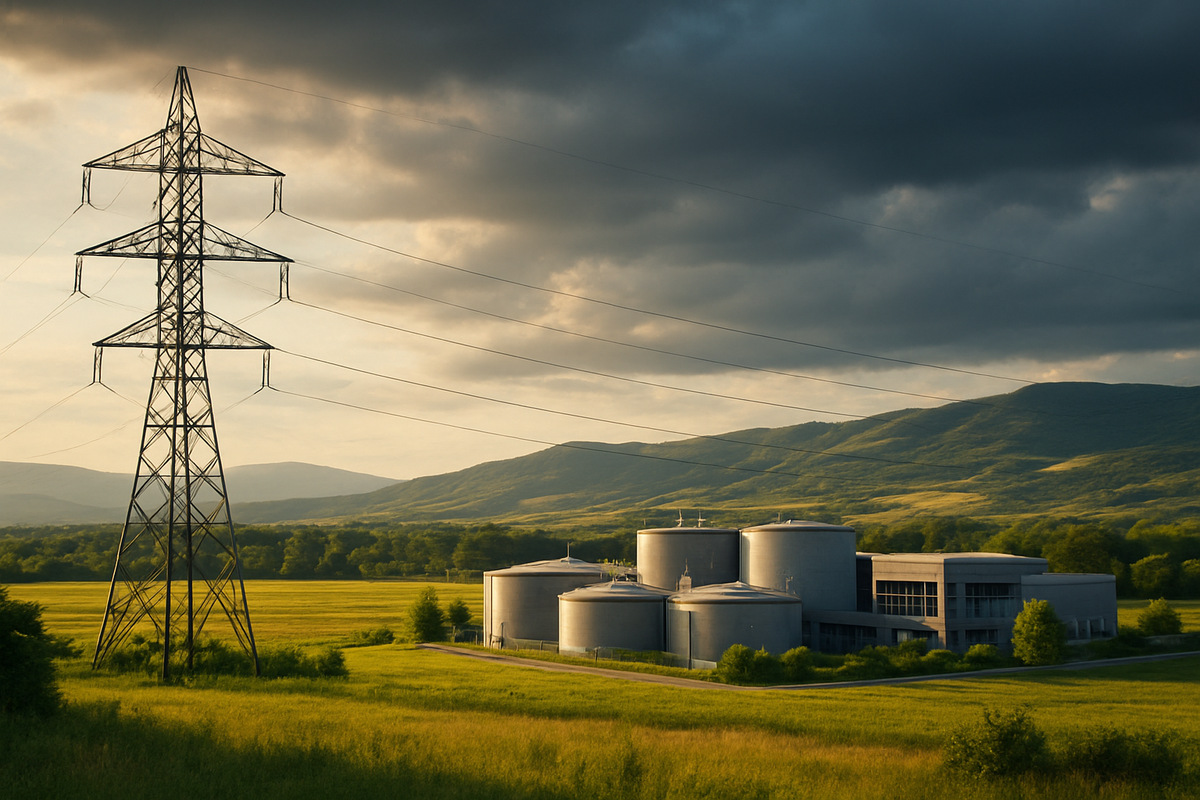
As the global economy navigates a landscape of subdued growth and persistent uncertainty, investors are increasingly turning to stalwart sectors known for their resilience and reliable income generation. Among these, utility stocks with robust dividend yields are emerging as a beacon of stability, offering a defensive play against the backdrop of fluctuating markets and geopolitical tensions. With the current date of October 24, 2025, the overarching economic narrative continues to be one of cautious optimism tempered by significant downside risks, making the predictable cash flows and attractive dividends of essential service providers more appealing than ever.
The appeal of utility companies lies in their fundamental role: providing indispensable services like electricity, water, and natural gas that consumers and businesses require irrespective of economic cycles. This inherent demand translates into stable earnings and consistent revenue streams, insulating these firms from the sharper swings experienced by more cyclical industries. For income-focused investors, the consistent dividend payouts—often exceeding 5% in select companies—offer a critical cushion against market volatility and a reliable source of returns, especially as central banks, including the Federal Reserve, are anticipated to deliver further easing into mid-2026. This environment of moderating inflation and potential interest rate cuts could significantly enhance the relative attractiveness of utility dividends, making them a cornerstone of a resilient investment strategy.
Resilient Dividends: Three Utility Giants Defying the Downturn
In a market environment where stability and income are paramount, certain utility companies stand out for their ability to deliver consistent performance and generous dividends, even amidst economic turbulence. These firms often boast strong regulatory frameworks, strategic infrastructure investments, and a commitment to shareholder returns that position them as attractive options for investors seeking refuge from uncertainty.
Consolidated Edison, Inc. (NYSE: ED), a venerable institution serving the metropolitan New York City area and Westchester County, exemplifies the defensive qualities of a utility stock. As of October 24, 2025, Consolidated Edison boasts an impressive dividend yield of approximately 5.26%. The company operates within a highly regulated environment, providing essential electric, gas, and steam services, which guarantees a predictable revenue stream largely insulated from broader economic fluctuations. Its remarkable track record includes increasing dividends for 50 consecutive years as of July 2025, cementing its status as a "Dividend King" and underscoring its financial fortitude and dedication to shareholder value. During the severe financial crisis of 2008, ED's stock saw a decline of merely 26%, a stark contrast to the S&P 500's approximately 55% fall, showcasing its robust defensive characteristics in times of extreme market stress. This consistent performance and commitment to dividends make it a cornerstone for income-focused investors prioritizing safety.
Another strong contender in the defensive utility space is Avista Corporation (NYSE: AVA), which provides electric and natural gas services primarily across the Pacific Northwest and Alaska. With a current dividend yield of approximately 5.04% as of October 24, 2025, Avista benefits from stable cash flows supported by a growing customer base in demographically favorable regions. The company has demonstrated a consistent ability to navigate economic downturns, notably outperforming the S&P 500 during the Great Recession of 2008-2009 and even delivering positive returns from 2008 to 2010. Its revenues also remained largely unaffected during the brief recession triggered by the COVID-19 pandemic. Avista's commitment to its shareholders is evident in its 22 consecutive years of dividend increases, highlighting its resilience and capacity to provide reliable income and returns even in challenging economic times.
Rounding out our trio is The AES Corporation (NYSE: AES), a diversified power generation and utility company with a global footprint, increasingly focused on renewable energy and energy storage. While its dividend yield on October 24, 2025, is approximately 4.93%, it has recently fluctuated above the 5% mark, with some reports earlier in 2025 indicating yields over 6%. AES has a commendable record of 12 consecutive years of dividend increases, reflecting a strong commitment to returning value to shareholders. The demand for electricity, a core service provided by AES, remains stable even during economic slowdowns, offering a significant defensive characteristic. Despite experiencing a notable dip during the Great Recession, AES demonstrated a swift recovery, indicating underlying operational resilience. The company's strategic pivot towards renewable energy positions it well for long-term growth, enhancing its stability and income potential for investors seeking defensive plays aligned with future energy trends. While some financial health concerns regarding debt levels exist, its dividend payments are well-covered by earnings.
The Broader Landscape: Utilities as Economic Barometers and Safe Harbors
The prominence of high-yield utility stocks during periods of economic uncertainty is not an isolated phenomenon but rather a reflection of deeper market dynamics and investor psychology. These companies often serve as economic barometers, their stable performance highlighting the essential, non-discretionary nature of their services. In an environment like October 2025, characterized by subdued global growth and persistent policy uncertainty, the defensive appeal of utilities becomes particularly pronounced.
This trend fits squarely into broader industry patterns where investors rotate into sectors with predictable earnings and strong balance sheets when growth prospects dim elsewhere. Utilities, by virtue of their regulated monopoly status in many regions, benefit from relatively stable revenue streams and often predictable rate increases, providing a clear line of sight to future earnings. This stability contrasts sharply with more cyclical industries, which are highly sensitive to consumer spending and industrial production. The potential for the Federal Reserve and other central banks to deliver further interest rate easing into mid-2026 could significantly bolster the attractiveness of utility dividends. While utilities can be sensitive to rising interest rates due to their capital-intensive nature and reliance on debt financing, a declining rate environment makes their consistent dividend yields more competitive against fixed-income alternatives and reduces their borrowing costs, thereby enhancing profitability.
Historically, utility stocks have consistently acted as safe havens during market downturns. During the dot-com bubble burst of the early 2000s and the 2008 financial crisis, the utility sector significantly outperformed the broader market, demonstrating its defensive prowess. Regulatory frameworks, while sometimes posing challenges with rate adjustments, generally provide a buffer against extreme market volatility by ensuring a reasonable rate of return on invested capital. The ongoing global push towards decarbonization and renewable energy also presents a unique opportunity for utilities like AES, which are actively investing in green infrastructure. This not only aligns with environmental, social, and governance (ESG) investing trends but also secures long-term growth avenues supported by policy mandates and increasing consumer demand for sustainable energy. The stability offered by these essential service providers creates a ripple effect, potentially drawing capital away from more speculative ventures and into foundational sectors, thereby stabilizing overall market sentiment to some extent.
Navigating the Future: What Lies Ahead for Defensive Utilities
Looking ahead, the trajectory for high-yield utility stocks appears robust, particularly given the prevailing economic forecasts for late 2025 and into 2026. In the short term, these companies are likely to continue attracting capital as investors seek to mitigate risk and secure reliable income streams amidst ongoing global economic flux. The anticipated easing of monetary policy by central banks could further enhance the appeal of utility dividends, making them more competitive against lower-yielding bonds and reducing the cost of capital for these infrastructure-heavy businesses. This could lead to continued outperformance relative to more growth-oriented sectors, especially if global growth remains muted.
In the long term, utility companies face both opportunities and challenges. The transition to renewable energy and the modernization of aging infrastructure represent significant capital expenditure requirements but also substantial growth opportunities. Companies like AES, with strategic investments in renewables, are well-positioned to capitalize on this megatrend, driving future earnings and potentially dividend growth. However, regulatory shifts, particularly concerning environmental mandates and rate-setting, will remain critical factors influencing profitability. The balance between investing in necessary infrastructure upgrades and keeping customer rates affordable will be a constant tightrope walk for regulators and utility executives alike. Furthermore, the increasing frequency and intensity of extreme weather events due to climate change pose operational and financial risks, requiring substantial investments in grid resilience.
Potential strategic pivots may include further diversification into renewable energy sources, enhanced grid modernization efforts to improve reliability and efficiency, and exploring new revenue streams through smart grid technologies and energy storage solutions. For investors, this environment presents opportunities to lock in attractive yields from fundamentally stable businesses while also gaining exposure to the long-term growth narrative of energy transition. However, vigilance will be key; investors should monitor interest rate movements, regulatory developments, and the capital expenditure plans of individual companies. Scenarios could range from continued steady performance if economic uncertainty persists and rates decline, to potential headwinds if inflation resurges, forcing central banks to maintain higher rates for longer, thereby increasing borrowing costs for utilities.
A Steady Hand in Stormy Seas: The Enduring Appeal of Utility Income
In summary, as of October 24, 2025, the global financial markets are characterized by a delicate balance of subdued growth and persistent uncertainty, making the defensive qualities of high-yield utility stocks exceptionally appealing. Companies like Consolidated Edison (NYSE: ED), Avista Corporation (NYSE: AVA), and The AES Corporation (NYSE: AES) stand out as prime examples, offering attractive dividend yields (often above 5%) coupled with a proven track record of stability during economic downturns. Their essential services, regulated business models, and commitment to shareholder returns position them as reliable anchors in an otherwise volatile investment landscape.
Moving forward, the market is likely to continue favoring sectors that offer predictability and income. The potential for further monetary policy easing by central banks could serve as a significant tailwind for utilities, making their dividend yields even more compelling relative to other income-generating assets. However, investors must remain cognizant of the sector's sensitivity to interest rate fluctuations, regulatory changes, and the substantial capital requirements for infrastructure modernization and the transition to renewable energy.
The enduring significance of these utility giants lies in their ability to provide a consistent income stream and a degree of capital preservation, acting as a crucial diversifier within a well-rounded investment portfolio. As economic headwinds persist, and the search for reliable returns intensifies, high-yield utility stocks are poised to maintain their status as a cornerstone for investors seeking stability and growth in an uncertain world. Investors should closely watch for shifts in interest rate expectations, evolving regulatory landscapes, and the strategic investments these companies make in future energy infrastructure to ensure their portfolios remain resilient.
This content is intended for informational purposes only and is not financial advice





